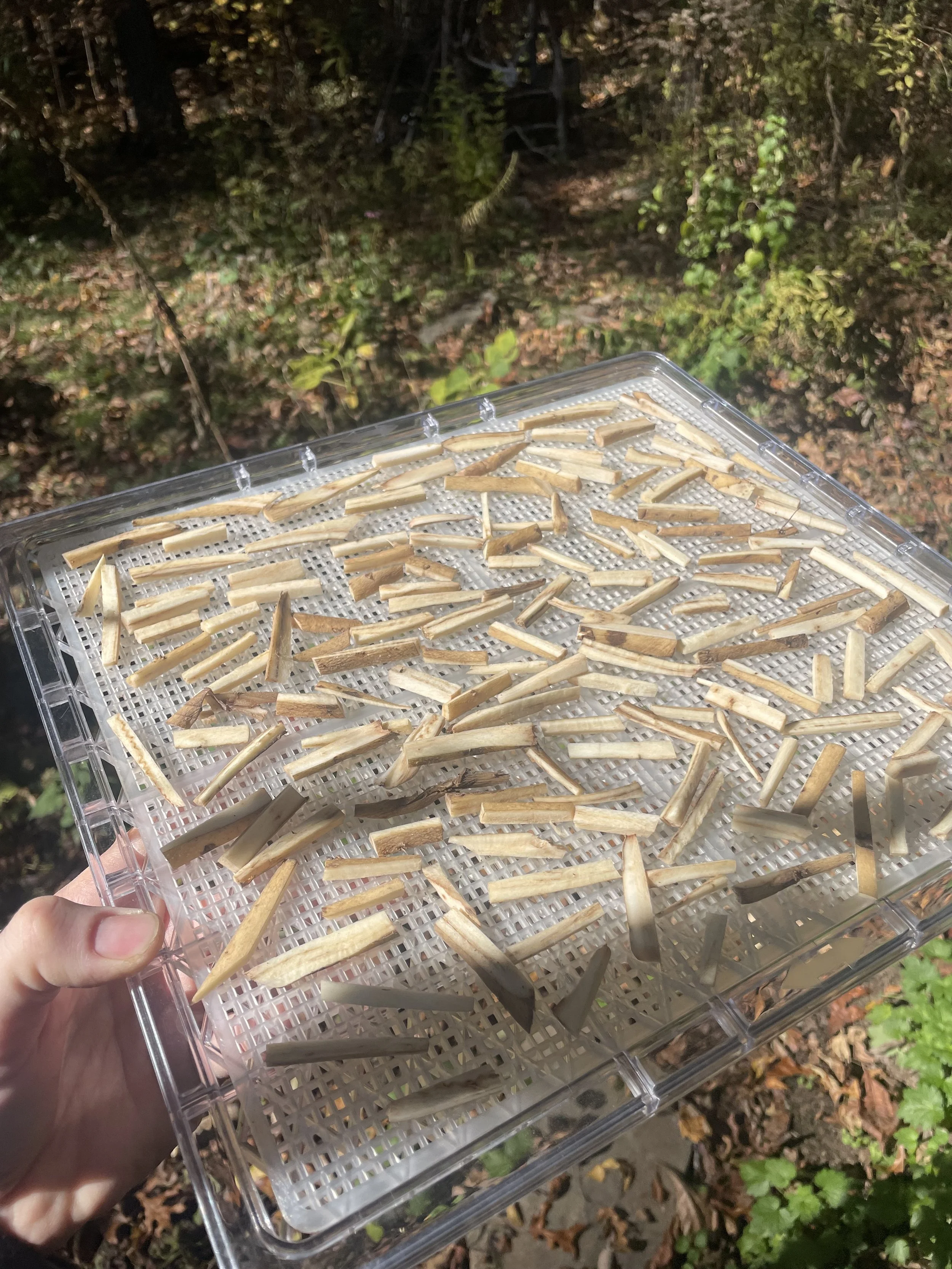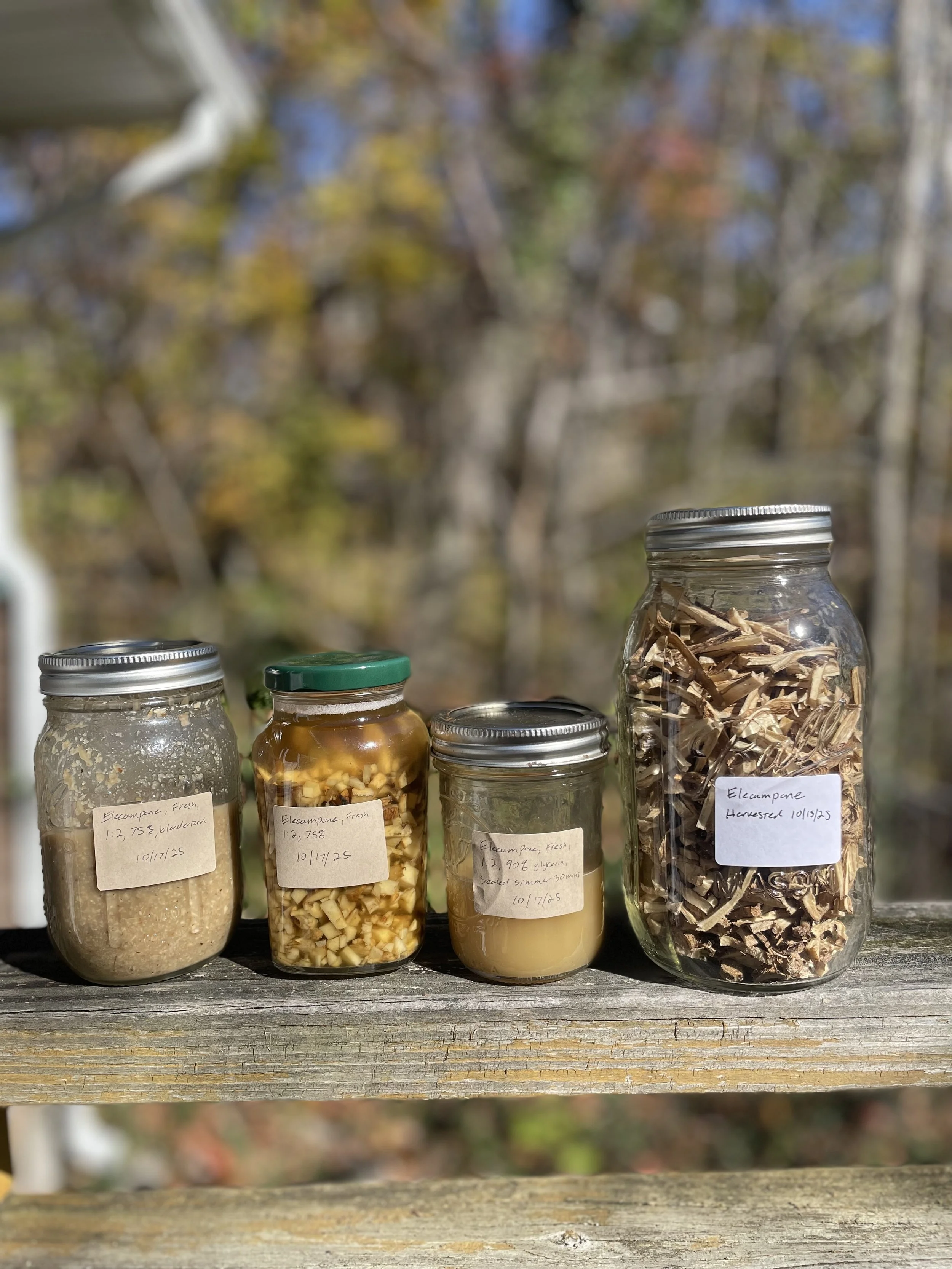Elecampane
I first met elecampane (Inula helenium) a decade ago (in October, actually, if I remember right). I was working at Sugar Loaf Mountain Herbs, and I came in one day with a cough I just couldn’t shake. It felt boggy, deep, cold. Alicia, the owner of the shop and one of the best herbalists I know, took one look at me and started brewing something. About ten minutes later she handed me a cup and told me a take a sip. It was warm, aromatic and I could feel my lungs opening up almost instantly. I took my first deep, full breath in probably a week, and then, over the rest of the day, proceeded to cough up everything that needed to be coughed up. I asked, of course, what was in the blend: elecampane and yerba santa (Eriodictyon californicum).
I was very early on in my herbal studies then, and that was one of the first times I can remember really feeling the power of plant medicine. Elecampane and yerba santa earned a permanent place on my shelves that day, and that was also my first real lesson on herbal energetics: take something warming and drying for damp, stagnant conditions.
The flavor of elecampane root is aromatic, slightly pungent, a little sweet, and almost a bit spicy. (We nibbled on a little of the fresh root in one of my classes recently and decided is has a kind of soapy taste, too. I kinda think if we were choosing a new common name we might have picked “lungsoap.”)
If I had to sum up the nature of elecampane in one word, I’d choose stimulating. It warms things up and gets them moving, clearing away damp stagnation. This stimulating expectorant, diuretic action means it can dry you out a bit - which is exactly what you need when you’ve got lax, saturated tissues. This is not the plant to work with if you’ve got a hot, irritated, dry tissue state on your hands.
While elecampane is traditionally used for respiratory situations, I’ve also found it to be really helpful for warming up and moving a cold sluggish digestion. The sweet starchy roots contain inulin, a polysaccharide found in the roots of some plants. The molecules of inulin are so large that they survive the upper GI and make it to the colon, where they act as a prebiotic that can help our gut flora flourish and, thereby, increase our nutrient absorption.
I think this ability to help us increase the nutrients we get from our food and strengthen our digestion is how it got one of it’s old Anglo-Saxon common names, Elf Dock, and its reputation as a medicine for those who were elf shot. Back in the day, before we had a firm grasp of germ theory or the concept of malabsorption, people believed that falling ill was the work or spirits or elves. If you had a long illness that left you weak, or were “failing to thrive” for no clear reason, people would say you were shot by a poisoned elf arrow. Elecamapane was given as a remedy to help restore your spirit and vitality after such an attack.
Beetles like elecampane too.
Botanically speaking, elecampane is a perennial in the Asteraceae family. It is native to Europe and western Asia, but is considered naturalized here in North America. It likes to grow in sunny places where the soil is moist, reaching a height of up to ten feet. It has large (up to two feet long) complete leaves that clasp the stem, and in July it bears big yellow flowerheads. The roots are what we work with as medicine, and those should be harvested in the fall when the energy of the plant has moved downward into the earth again.
Despite working with the dried roots of this plant for around ten years, this past summer was the first time I met a real, live elecampane plant in person. Being in its presence was something else - all plants have a sort of vibe going on, but elecampane has an incredibly strong one.
Last week I had the opportunity to harvest the roots from two wild plants (there were many around). The root crown isn’t too deep in the soil and the roots like to spread out rather than down - after some careful excavation, the roots weren’t too difficult to lift out. I spent a good part of my night when I got home scrubbing any remaining dirt from the roots. I did cut off a few pieces of the crown and planted them in my herb garden - we will see how they fare.
The earth-heart of an elecampane root.
Once clean, I laid the roots out to surface-dry for a day or so, which gave me time to scheme about exactly what I wanted to make with them. I decided I had enough to experiment by making a very small batch of glycerite, a “normal” tincture, and a blenderized tincture. The rest I dried for later by chopping it into small thin matchsticks, then putting it in my dehydrator for 2 hours at 105F, followed by 12 hours at 95F. Low and slow is the way to go when you’re trying to preserve those precious volatile oils. This process seems to have worked very well and dried them perfectly. Now they’re stored neatly away in a glass jar, ready for brewing over the winter.
Prepped for drying.
If you know me you know I’ve been on a glycerite kick for the past few years, and so I was really excited to experiment with the fresh root. I went with a 1:2 ratio of 90% vegetable glycerin, sealed and simmered in a hot water bath for 30 minutes. The results are outstanding - glycerin is so good at pulling our those volatile oils, and the flavor profile of elecampane is perfectly preserved.
As for the tinctures, I made one with finely chopped root at a ratio of 1:2 in 75% alcohol. I used the same ratio and percentage with the second one, but I blenderized it. We’ll have to wait and see how much of a difference there is between them - I’ll come back and update when I know more!






